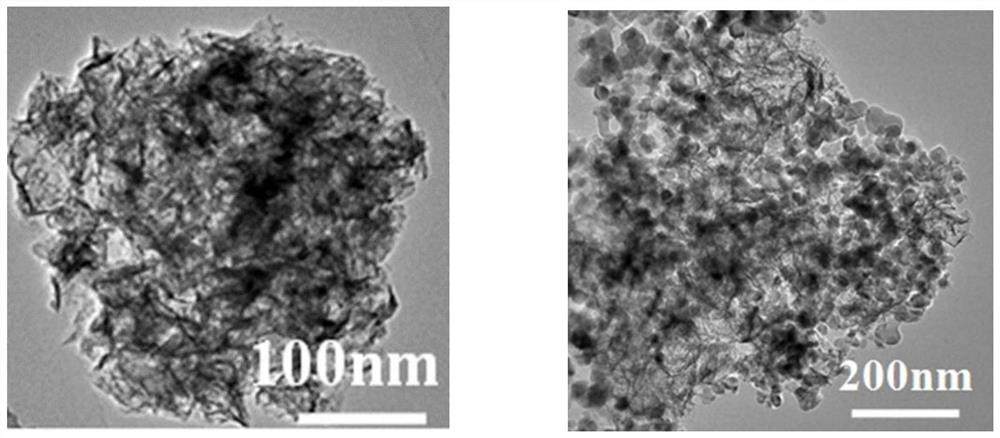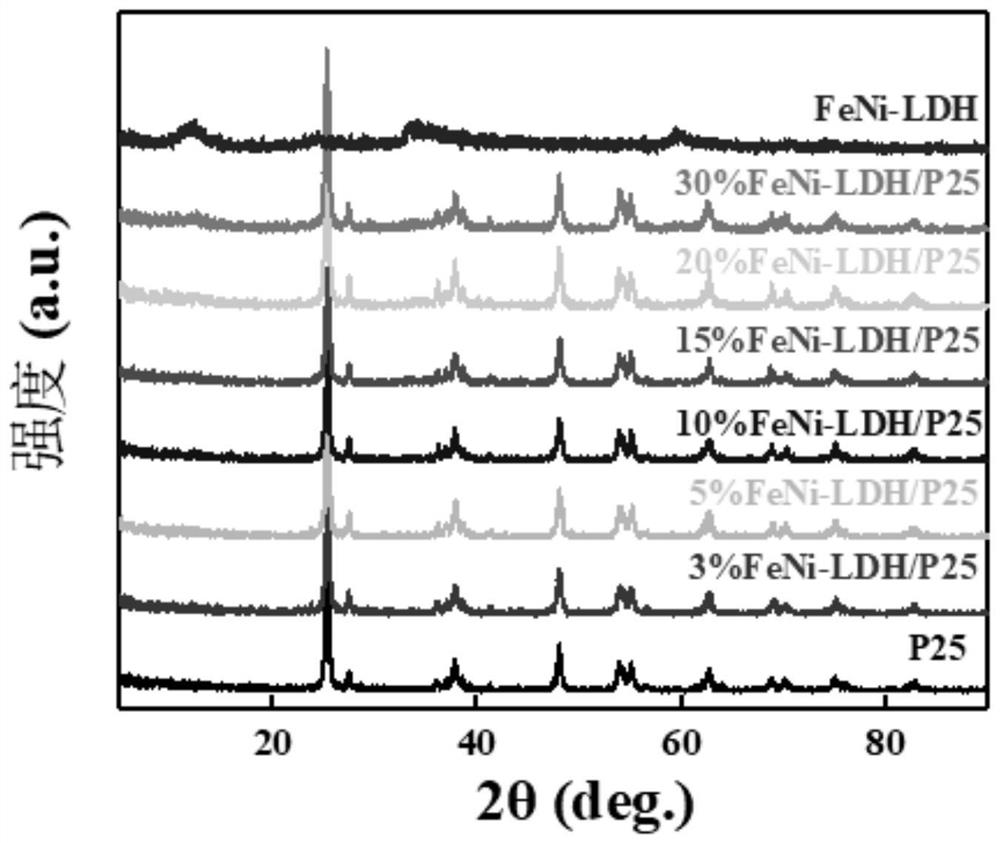A composite nanomaterial for photocatalytic decomposition of water to produce hydrogen and its preparation method
A composite nanomaterial and photocatalytic technology, which is applied in the field of photocatalytic water decomposition hydrogen production materials and its preparation, can solve the problems of poor hydrogen production effect of P25 photocatalyst, and achieve good application prospects, good stability and high conductivity. Effect
- Summary
- Abstract
- Description
- Claims
- Application Information
AI Technical Summary
Problems solved by technology
Method used
Image
Examples
Embodiment 1
[0032] (1) Nickel (0.32 g) of hexahydrate and nine-water (0.44 g) was added to ultrapure water (20 ml) to mix the proportion of 1: 1, to obtain a uniform dispersion, and then dispersed The mixed solution was transferred to a single neck flask, and N-methylpyrrolidone (30 mL) was heated in the dispersion, heated at 90 ° C for 4 h, naturally cooled to room temperature, washing, freeze, and dried to give Feni-LDH nano sheet.
[0033](2) The above Feni-LDH (20 mg) was pulverized in anhydrous ethanol (20 mL), and the cells were dispersed and uniform, and then the P25 nanoparticles were weighed in anhydrous ethanol solution according to the mass ratio of 5%. Mechanically at room temperature for 12 h, since the Feni-LDH surface belt positively charged, the P25 nanoparticle belt negative electricity can be assembled together by mechanically stirring, and then placed in a blast dryer of 60 ° C, drying, The time was 8 h, which was obtained for Feni-LDH / P25 complex nanomaterial for photoca...
Embodiment 2
[0035] (1) Nickel (0.63 g) of hexahydrate (0.63 g) and nine-water mixture (0.44 g) was stirred in ultrapure water (20 mL) to obtain a uniform dispersion, and then dispersed mixed solution Transfer to a single neck flask, an additional N-methylpyrrolidone (30 mL) in the dispersion in the dispersion, heated at 100 ° C for 5 h, naturally cooled to room temperature, washing, freeze, and dried to give Feni-LDH nano sheet.
[0036] (2) The above Feni-LDH (20 mg) was pulverized in anhydrous ethanol (20 mL), and the cells were dispersed and uniform, and then the P25 nanoparticles were weighed in anhydrous ethanol solution according to the mass ratio of 10%. Mechanically at room temperature for 12 h, since the Feni-LDH surface belt positively charged, the P25 nanoparticle belt negative electricity can be assembled together by mechanically stirring, and then placed in a blast dryer of 60 ° C, drying, The time was 8 h, which was obtained for Feni-LDH / P25 complex nanomaterial for photocatal...
Embodiment 3
[0038] (1) Nickel (0.98 g) of hexahydrate (0.44 g) and nine-water (0.44 g) were added to the proportion of 3: 1 to 3: 1, and the uniform dispersion is obtained, and then dispersed A good mixed solution was transferred to a single neck flask, and an additional N-methylpyrrolidone (30 mL) in the dispersion in the dispersion, heated at 110 ° C for 6 h, naturally cooled to room temperature, washed, freeze dry, gave Feni- LDH.
[0039] (2) The above-mentioned Feni-LDH (20 mg) was pulverized in anhydrous ethanol (20 mL) to obtain a solution of a uniform solution, and then the P25 nanoparticles were weighed according to the mass ratio of 15%, placed in anhydrous ethanol solution. Mechanically at room temperature for 12 h, since the Feni-LDH surface belt positively charged, the P25 nanoparticle belt negative electricity can be assembled together by mechanically stirring, and then placed in a blast dryer of 60 ° C, drying, The time was 8 h, which was obtained for Feni-LDH / P25 complex nan...
PUM
| Property | Measurement | Unit |
|---|---|---|
| concentration | aaaaa | aaaaa |
Abstract
Description
Claims
Application Information
 Login to View More
Login to View More - R&D
- Intellectual Property
- Life Sciences
- Materials
- Tech Scout
- Unparalleled Data Quality
- Higher Quality Content
- 60% Fewer Hallucinations
Browse by: Latest US Patents, China's latest patents, Technical Efficacy Thesaurus, Application Domain, Technology Topic, Popular Technical Reports.
© 2025 PatSnap. All rights reserved.Legal|Privacy policy|Modern Slavery Act Transparency Statement|Sitemap|About US| Contact US: help@patsnap.com



